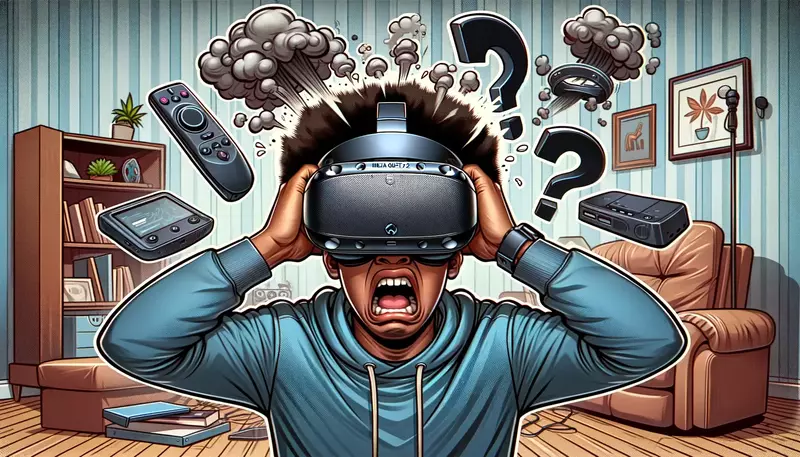This site contains affiliate links to products, and we may receive a commission for purchases made through these links.
Virtual Reality is a new and exciting technology that has taken the world by storm. It offers an immersive experience that allows people to step into another world. But how long can you play in VR per session?
While you can play as long as you want in VR, it is important to take breaks every 30 minutes or so. This will help prevent eye strain and dizziness. It is also a good idea to have someone else in the room with you so they can keep an eye on you and make sure you are okay.
Below I go deeper into this topic and answer some frequently asked questions.

How Long Should You Play in VR Per Session?
There is no set amount of time that you should play in VR per session. However, as a rule of thumb, it is good to take breaks every 30 minutes or so. This will help prevent eye strain and dizziness.
As long as you are comfortable and not experiencing any negative side effects, you can play in VR for as long as you want. Just be sure to take breaks and stay hydrated.
READ MORE! Can I Use The Meta Quest 2 While Charging? (Solved!)
What Are the Risks of Playing in VR for Too Long?
There’s a raft of potential risks associated with playing in VR for too long. They include:
1. Eye Strain
This is among the most common complaints from people who spend too much time in VR. Because you are looking at a screen for extended periods, your eyes can get tired and sore.
To help combat this, take breaks every 30 minutes or so and try to blink often.
2. Dizziness
Another common side effect of spending too much time in VR is dizziness. This is caused by the vestibular system becoming overloaded. When this happens, you may feel like you are spinning or that the world is moving around you.
To help avoid this, take breaks often and try to stay still when you are not playing. If you start to feel dizzy, sit down until the feeling passes.
3. Dehydration
When you are immersed in a game, it can be easy to forget to drink water.
However, it is important to stay hydrated when playing in VR. Dehydration can cause a number of problems, including headaches, fatigue, and dry eyes.
4. Seizures
There have been a few reports of people having seizures while playing in VR. While this is rare, it is still something to be aware of.
If you have a history of seizures, it is best to avoid VR altogether.
5. Motion sickness
This is another common side effect of VR. It is caused by the vestibular system becoming overloaded and can lead to nausea and vomiting. Motion sickness is more likely to occur if you are playing a game that involves a lot of movement.
If you start to feel nauseous, take a break and sit down. You may also want to try an over-the-counter medication like Dramamine.
6. Cybersickness
While not as well-known as motion sickness, cybersickness is a similar condition that can be caused by spending too much time in VR.
Symptoms include headaches, eye strain, and fatigue.
7. VR can be addictive
While it sounds like something out of a science fiction movie, VR addiction is a real phenomenon. Some people become so obsessed with playing in VR that they neglect their work, school, and relationships.
If you find yourself losing track of time or skipping meals while playing in VR, it may be time to take a break.
Finally, I must mention that long-term exposure to VR may have other negative effects on your health, including changes in brain function. More research is needed on this topic, but it is something to be aware of.
READ MORE! Can You Enter Virtual Reality Without A Headset? (Solved!)
Tips for Playing in VR Safely for Extended Periods
If you want to play in VR for extended periods, there are a few things you can do to help reduce the risks:
Take breaks often. As mentioned above, it is a good idea to take breaks every 30 minutes or so. This will help prevent eye strain and dizziness.
Stay hydrated. Drinking plenty of water will help keep you from getting dehydrated. Be sure to drink even if you don’t feel thirsty.
Choose your games wisely: Some games are more likely to cause motion sickness than others. If you are prone to cybersickness, it is best to avoid games that involve a lot of movement.
Sit down when playing. This will help reduce the risk of dizziness and nausea. Note that some games may not be playable while sitting down.
Wear a comfortable VR headset: You want to get a headset that is comfortable and doesn’t put too much pressure on your head. This will help reduce the risk of headaches.
If you start to feel any negative effects, take a break: If you start to feel dizzy, nauseous, or have a headache, it is time to take a break. It is better to stop playing for a while than to push through the discomfort and risk further health problems.
Use prescription lens adapters: This is especially helpful if you wear glasses. Lens adapters can help reduce eye strain and make it easier to see the VR world clearly.
Follow these tips and you should be able to play in VR for extended periods without any problems. Just remember to listen to your body and take breaks when needed.
FAQs
Can I play in VR for hours?
Is VR bad for my eyes?
Can VR make me sick?
Final Thoughts
How long you play in VR depends on a variety of factors, including your comfort level, the game you’re playing, and your overall health.
It is generally safe to play for extended periods as long as you take breaks often and listen to your body.

Espen
Espen is the Director of PursuitMeta and has written extensively about Virtual Reality and VR Headsets for years. He is a consumer product expert and has personally tested VR Headsets for the last decade.




Leave a Reply